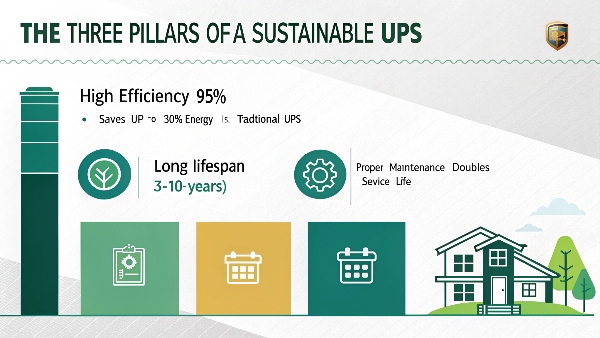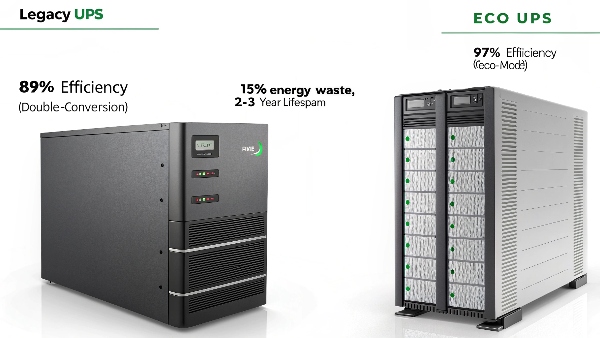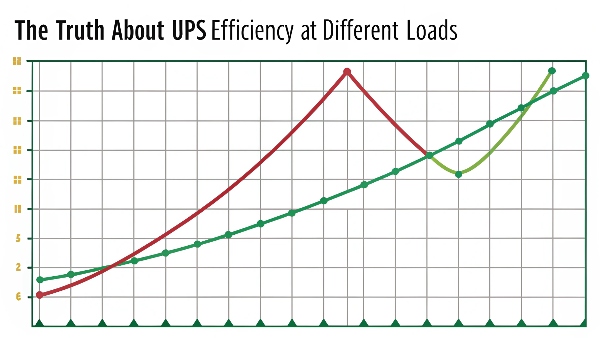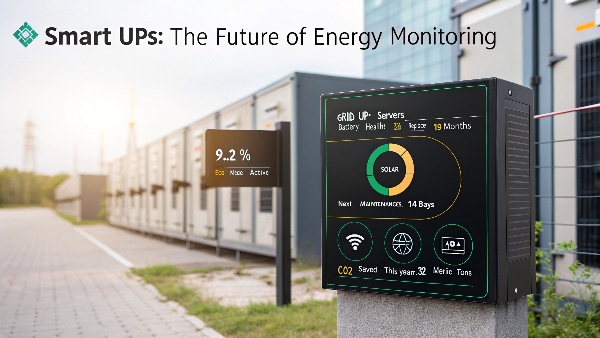The world's data centers now consume more electricity than some small countries. Much of this powers UPS systems that sit idle most of the time. What makes a UPS truly sustainable?
Sustainable UPS systems must meet three key criteria: 1) High operational efficiency (95% or above in Eco mode), 2) Long service life (5-10+ years with proper maintenance), and 3) Eco-friendly materials and recyclability (meeting RoHS and WEEE standards).

I recently audited a financial firm's server room and found their 10-year-old UPS units were wasting enough electricity to power 15 homes annually. This sparked my deep dive into UPS sustainability standards.
Purchasing Energy-Efficient Uninterruptible Power Supplies
Corporate buyers often focus only on upfront cost, ignoring the 5-7 year energy expenditure that typically exceeds purchase price. Here's what truly matters when selecting efficient UPS systems.
Look for UPS models with: 1) Eco mode operation (96%+ efficiency), 2) Wide input voltage window (less battery use), 3) Modular design (scale capacity as needed), and 4) Thermal management systems (cooling represents 10-15% of energy use).
Energy-Efficient UPS Buying Guide:
| Feature | Efficient Choice | Less Efficient Alternative |
|---|---|---|
| Topology | Modular Multi-Mode | Traditional Double-Conversion |
| Efficiency | 96-99% Eco Mode | 90-94% Standard Mode |
| Cooling | Variable Speed Fans | Fixed Speed Cooling |
| Battery | Lithium-Ion | VRLA Lead-Acid |
| Monitoring | Advanced Predictive Analytics | Basic Alarm Systems |
Real-World Impact Example:
- 10kW UPS running 24/7
- 94% efficient = 6,383 kWh annual waste
- 97% efficient = 2,628 kWh waste
- Savings: 3,755 kWh/year (~$500)
Our manufacturing client reduced their UPS energy costs by 28% simply by upgrading to newer high-efficiency models. The ROI came in just 2.3 years through electricity savings alone.

What Is UPS Efficiency And How Is It Calculated?
Efficiency metrics can be misleading without proper context. Many manufacturers highlight peak efficiency while hiding real-world performance under partial loads.
UPS efficiency is calculated as: (Power Out ÷ Power In) × 100. Crucial measurements include: 1) Full load efficiency (100% capacity), 2) Typical load efficiency (30-70% capacity), and 3) Eco mode efficiency (bypass operation with monitoring).
Efficiency Comparison at Different Loads:
| Load % | Traditional UPS | High-Efficiency UPS | Difference |
|---|---|---|---|
| 25% | 88% | 95% | +7% |
| 50% | 91% | 96% | +5% |
| 75% | 92% | 97% | +5% |
| 100% | 93% | 97% | +4% |
Key Observations:
- Most UPS systems run at 30-50% load
- Efficiency drops dramatically below 20% load
- Multi-mode units maintain higher efficiency across range
- Transformerless designs typically more efficient
When testing units for a hospital project, we found some models lost up to 12% efficiency when power quality fluctuated. Always verify manufacturer claims with independent test data.

Five practical ways to maximise your UPS's energy efficiency
Maintenance matters as much as initial selection. Here are actionable strategies we've used to cut clients' UPS energy waste by 15-30%.
1) Right-size your UPS (avoid oversizing), 2) Implement thermal management (clean filters, proper ventilation), 3) Upgrade to lithium batteries (30%+ efficiency gain), 4) Utilize eco/sleep modes (when conditions allow), 5) Regular firmware updates (optimize algorithms).
Efficiency Improvement Checklist:
| Action | Potential Savings | Implementation Difficulty |
|---|---|---|
| Load optimization | 5-15% | Medium |
| Battery upgrade | 10-30% | High |
| Eco mode enablement | 3-8% | Low |
| Preventative maintenance | 2-5% | Low |
| Firmware updates | 1-3% | Very Low |
Case Study:
- 20-module UPS installation
- Original efficiency: 92% at 40% load
- After optimization: 96% efficiency
- Annual savings: $8,700 electricity
- CO₂ reduction: 12.5 metric tons
Our most dramatic result came from combining module synchronization with variable speed cooling. The data center saved $23,000 annually on a 40-module system deployment.

What is the purpose of a UPS (uninterruptible power supply)?
Beyond simple battery backup, modern UPS systems serve multiple critical functions that impact sustainability. Their role has evolved significantly in the past decade.
Primary UPS purposes: 1) Clean power conditioning (remove surges/sags), 2) Bridge short outages (typically 5-15 min), 3) Enable graceful shutdowns, 4) Improve power quality (THD <5%), and 5) Provide runtime telemetry for capacity planning.
UPS Functions and Sustainability Impact:
| Function | Energy Impact | Sustainability Benefit |
|---|---|---|
| Voltage Regulation | Medium | Reduces equipment waste |
| Frequency Control | Low | Prevents data corruption |
| Harmonic Filtering | High | Cuts transformer losses |
| Surge Protection | None | Extends device lifespan |
| Battery Management | High | Optimizes energy storage |
Emerging Smart UPS Capabilities:
- Predictive battery replacement1
- Load balancing across phases
- Grid-interactive operation2
- Renewable energy integration3
- Thermal optimization algorithms
At a university data center project, we implemented UPS systems that interact with campus solar arrays. During sunny days, some UPS units go into standby while others store excess solar energy - reducing grid dependence by 18%.

Conclusion
Sustainable UPS systems require high efficiency, long service life, and eco-friendly materials. Proper selection, sizing, and maintenance can reduce energy waste by 30% while extending equipment lifespan. Smart UPS technologies continue advancing sustainability potential.
-
Understanding predictive battery replacement can enhance your knowledge of UPS efficiency and maintenance strategies. ↩
-
Learning about grid-interactive operation can provide insights into optimizing energy use and reducing costs. ↩
-
Exploring renewable energy integration can reveal innovative ways to enhance sustainability in power systems. ↩

